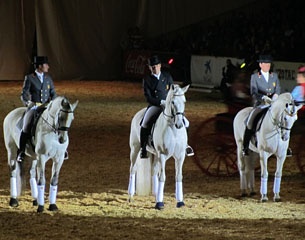
Another year, another SICAB. For those of you who don’t know what I’m talking about—it’s the world’s largest horse show that almost no one outside of Spain knows about.
For those of you who do, you know exactly what this week entails: another missed Thanksgiving, another week of ham, smoke, and cerveza, another five days of frustration and exhilaration, another disappointing dressage class or two, all with absolutely no regrets. And though you’ll say you won’t be back, you know you’ll be there next year.
SICAB is a breed show—claiming to be the largest trade show in the world for a single item, the Pure Spanish Horse, or the PRE (Pura Raza Espanola). It is hosted by ANCCE, the PRE Breed Association that also manages the official PRE Studbook. It is underwritten by large corporate sponsors including Iberia Airlines, Cruzcampo Beer, Opel Cars, Purina, and the European Union, to name a few. As a show, the production is staggering: hundreds of horses competing in conformation (morphology) and sport classes, five pavilions bulging with shops, hospitality booths, breeders stands, press stalls, bars and cafes, open horse boxes, and over 100,000 people milling through it all. You have children everywhere—in strollers or running alongside their parents, or in long lines with their teachers. You have the locals—primarily agricultural people in some way or another or regular Andalusians, who as a general population tend to be more horse savvy than most, since horses take part in almost every holiday they celebrate. You have the exhibitors, the mozos, the grooms, the handlers, the presenters, the riders, the beautiful girls selling sherry, the show officials—who move through the day huddled together in a little group, like all judging panels everywhere—the prominent farm owners in fine English wools hosting large groups in their elaborate stands, the ANCCE VIPS, who are dressed for business and who can be seen rushing through a crowd with a European celebrity or, as we saw last Tuesday night, with a member of the royal family. And then there are the foreigners, the Northern Europeans and Americans who move around the show conspicuously and who also tend to huddle, when not being encircled by agents for the biggest breeders. It’s a horse extravaganza that has to be seen to be realized.
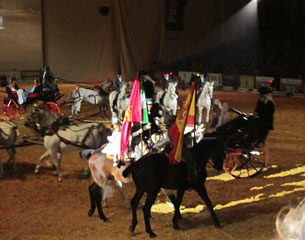 The major focus of the show is the morphology competition. Throughout the year, breeders present their horses in a circuit of regional shows around Spain in order to qualify to be among the top 40 in each gender and age group, who are then invited to compete at SICAB. Just to be invited is considered an honor. The in-hand presentation shows three gaits on the lunge, including the canter, and following two rounds, the top 12 ranked horses must do a functionality test—a lower level dressage test in dressage tack. Movement in hand and under saddle form a portion of the overall score, but the greatest emphasis is on conformation. Winners of these classes become top breeding stallions or are sold for often six-figure prices. In addition to the morphology, ANCCE sponsors “Copas” or Cups throughout the year in all the major equestrian disciplines. The two most popular are the traditional Doma Vaquera and Dressage, called Doma Clasica there. The Dressage classes are held in a large indoor auditorium and the stands are for the most part full for the FEI classes. The Copas are only open to registered PRE Horses and horses can obtain qualifying scores at most of the open national competitions during the year.
The major focus of the show is the morphology competition. Throughout the year, breeders present their horses in a circuit of regional shows around Spain in order to qualify to be among the top 40 in each gender and age group, who are then invited to compete at SICAB. Just to be invited is considered an honor. The in-hand presentation shows three gaits on the lunge, including the canter, and following two rounds, the top 12 ranked horses must do a functionality test—a lower level dressage test in dressage tack. Movement in hand and under saddle form a portion of the overall score, but the greatest emphasis is on conformation. Winners of these classes become top breeding stallions or are sold for often six-figure prices. In addition to the morphology, ANCCE sponsors “Copas” or Cups throughout the year in all the major equestrian disciplines. The two most popular are the traditional Doma Vaquera and Dressage, called Doma Clasica there. The Dressage classes are held in a large indoor auditorium and the stands are for the most part full for the FEI classes. The Copas are only open to registered PRE Horses and horses can obtain qualifying scores at most of the open national competitions during the year.
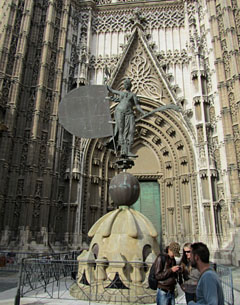 I’ve been coming to Sevilla for SICAB since 1999. Those of us who make the trip every year have come to expect little change. After the Spanish Dressage Team took the silver at the Athens Olympics in 2004, we hoped for some kind of Olympic theme or promotion, but nothing changed. Only an additional act was added to the nightly program (the Espectaculo). This year not only follows the most successful performance of a Spanish sport horse at the World Equestrian Games in Kentucky (Fuego XII who finished Fourth in the World), but it marks the 20th Anniversary of SICAB. There was a bit more mention made of the Anniversary than of the success of the Spanish Team, but essentially, the show was the same as it has been for at least the ten years that I’ve attended. This isn’t really lack of vision, it’s just the Andalusian way—which I’ve come to understand slowly and appreciate progressively over the years for what it is.
I’ve been coming to Sevilla for SICAB since 1999. Those of us who make the trip every year have come to expect little change. After the Spanish Dressage Team took the silver at the Athens Olympics in 2004, we hoped for some kind of Olympic theme or promotion, but nothing changed. Only an additional act was added to the nightly program (the Espectaculo). This year not only follows the most successful performance of a Spanish sport horse at the World Equestrian Games in Kentucky (Fuego XII who finished Fourth in the World), but it marks the 20th Anniversary of SICAB. There was a bit more mention made of the Anniversary than of the success of the Spanish Team, but essentially, the show was the same as it has been for at least the ten years that I’ve attended. This isn’t really lack of vision, it’s just the Andalusian way—which I’ve come to understand slowly and appreciate progressively over the years for what it is.
SICAB has its critics. All kinds of rumors and scandal surround the morphology rings, often centering on corruption of the judging, just like all breed shows everywhere. The breed association itself, ANCCE, is the perennial villain that breeders can’t live with or without. In the performance rings, particularly in the dressage classes, the criticisms are more grounded and urgent. The top-ranked PREs in the country often take a pass from SICAB, and the quality of the Grand Prix can fluctuate from a class full of exciting young horses on the verge of their international careers (as in 2009) to a small class of questionable quality with one or two exceptions. This year’s performances by Victor Alvarez on his young horse Curioso, and the lovely Teresa Jacquicoa on her dreamy Impaciente were definite high points for the week, both scoring over 70% in the Grand Prix Kur. Nevertheless, a recent article in the Spanish press aptly illustrates the frustrations of the riders in the conditions for the Dressage show—poor stabling, poor footing, shared warm-up arenas, late starts for the classes, etc.—and for this reason, a number of good horses and riders choose not to take the risk for an unrated show.
For visitors who are looking for Dressage horses, every year it’s the same: the best horses appear in the younger classes, both in-hand and under saddle. As you sit through the progression of 4, 5, and 6 year old classes, the field of quality begins to narrow and by the Prix St. George and Grand Prix, you are wondering where are all the good horses? This is the biggest problem with the Spanish system of selecting horses and bringing them along for international competition. My opinion has always been that Spain is full of good horses, and yet so few make it into the hands of top riders who can compete them at top levels. Why is this and why has the world-class success of a few not brought the same opportunities to so many others? The full answer to this is complicated and a topic for another day, but the conundrum is best illustrated at SICAB.
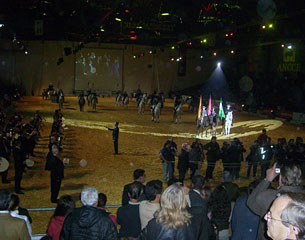 I would venture to say that the breed industry, or better, the in-hand industry, in Spain is unique in the sport horse world in that it is the driving force behind all other disciplines or uses for the PRE horse. (You will notice that I refer to the PRE as a sport horse, which has been unquestionably proven and re-proven only recently.) The standards for PRE breed champions are far more demanding than for other sport horse breeds (the head of the horse alone is judged on eight basic skull dimensions) and even the most skeptical eye would find the well-bred PRE horse a thing of true beauty. SICAB champions rarely go on to a performance career, as they’ve already obtained the pinnacle. Breed champions will regularly sell for far more than riding horses, and those that are sold are exported to new homes in places like New Zealand, Mexico, China and Saudi Arabia, to new owners who may want them just as an object of beauty. The market for SICAB champions has remained relatively healthy in spite of the crisis that has affected the horse world dramatically in Spain. Generally speaking, North American buyers are in Spain for breeding prospects—the United States has hundreds of PRE breeders who have created their own industry apart from the performance world. This is a big reason for the fact that so many young, gifted PRE horses never enter a dressage ring.
I would venture to say that the breed industry, or better, the in-hand industry, in Spain is unique in the sport horse world in that it is the driving force behind all other disciplines or uses for the PRE horse. (You will notice that I refer to the PRE as a sport horse, which has been unquestionably proven and re-proven only recently.) The standards for PRE breed champions are far more demanding than for other sport horse breeds (the head of the horse alone is judged on eight basic skull dimensions) and even the most skeptical eye would find the well-bred PRE horse a thing of true beauty. SICAB champions rarely go on to a performance career, as they’ve already obtained the pinnacle. Breed champions will regularly sell for far more than riding horses, and those that are sold are exported to new homes in places like New Zealand, Mexico, China and Saudi Arabia, to new owners who may want them just as an object of beauty. The market for SICAB champions has remained relatively healthy in spite of the crisis that has affected the horse world dramatically in Spain. Generally speaking, North American buyers are in Spain for breeding prospects—the United States has hundreds of PRE breeders who have created their own industry apart from the performance world. This is a big reason for the fact that so many young, gifted PRE horses never enter a dressage ring.
One can claim that the breeding industry—and its influence on horse selection—has interfered or held back the development of dressage horses in Spain, and there is merit to this argument. At the same time, as you look around at the tremendous economic impact a show such as SICAB brings to the equine industry, the horse breeders and the community, you also realize that in these fragile times, the breeding industry has remained a powerful economic force on the side of the local breeder and the dressage rider alike, continuing to develop and promote the PRE horse world-wide. SICAB, for all its flaws, does the job. I’ve brought many people to SICAB from the horse world over the years, and not one walks away without amazement at the ability of the trained horses, the temperament of the stallions, the kindness of the mares stabled together in open boxes in rooms filled with people, and the promise of the young horses in the hands of their presenters.
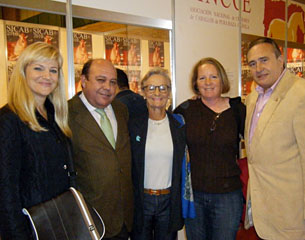 Better times will bring more top horses to the surface, as more breeders (who are the main sponsors of dressage riders in Spain) are able again financially to put horses in the show ring with dressage riders. Hopefully, more clinics and training opportunities will become available to these riders in the future, new appointments at ANCCE will improve the riding conditions at the show, and we will have more good years at the Grand Prix at SICAB. But for the discerning eye, SICAB is still the place where the best PRE horses in the world can be found. For all its shortcomings, SICAB still shows the PRE horse in its very best light. After all, it was at SICAB just a few years ago, that one of the biggest breeders in Spain spotted a promising young horse from a no-name breeder in the Four Year Old Functionality test. The horse was Fuego XII, the breeder was Don Miguel Angel Cardenas, and the rest is history.
Better times will bring more top horses to the surface, as more breeders (who are the main sponsors of dressage riders in Spain) are able again financially to put horses in the show ring with dressage riders. Hopefully, more clinics and training opportunities will become available to these riders in the future, new appointments at ANCCE will improve the riding conditions at the show, and we will have more good years at the Grand Prix at SICAB. But for the discerning eye, SICAB is still the place where the best PRE horses in the world can be found. For all its shortcomings, SICAB still shows the PRE horse in its very best light. After all, it was at SICAB just a few years ago, that one of the biggest breeders in Spain spotted a promising young horse from a no-name breeder in the Four Year Old Functionality test. The horse was Fuego XII, the breeder was Don Miguel Angel Cardenas, and the rest is history.
by Kimberly Van Kampen Boyer
Hampton Green Farm
© Eurodressage.com
Related Links
Munoz Diaz and Fuego XII, Kings of Hearts at the 2010 World Equestrian Games
Annual Iberian Horse Extravaganza at SICAB